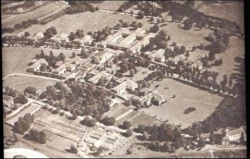Northern State Hospital
| Northern State Hospital | |
|---|---|
 | |
| Established | 1909 |
| Construction Began | 1911 |
| Opened | April 1, 1911 |
| Closed | 1973 |
| Current Status | Closed |
| Building Style | Cottage Plan |
| Location | Sedro-Woolley, WA |
| Alternate Names |
|
Contents
[hide]History[edit]
The institution was established in 1909 on a tract of land at Sedro-Woolley and was originally a farm for harmless patients under the direction of the superintendent of the Western Hospital at Fort Steilacoom. In 1911 the hospital was separated from the Western Hospital and quickly became the largest in the state. The new hospital opened April 1, 1911. Dr. A. H. McLeish was the first superintendent. He served until August 5, 1913 when he resigned and was succeeded by Dr. W. E. Cass. On February 1, 1914, Dr. Cass was succeeded by superintendent, Dr. J. W. Doughty, who was promoted from the position of first assistant physician at the Western Hospital for the Insane.
The hospital consisted of four cottages or ward buildings. They are two stories in height, with basement, of concrete construction, with tile roofs; strictly fireproof and arranged in accordance with the most modern and approved plans for hospital buildings of the time. Special attention was given to heating, lighting and ventilation, in order to afford the greatest degree of comfort to the patients. The kitchen building was of comprises several departments, including attendants' dining room, bakery, kitchen, refrigerating and store rooms.
A reinforced concrete tunnel, 5 feet 6 inches inside measurement, carried steam and electric lines from the power house to the patient buildings. A large amount of work was put into cleaning and cultivating additional land, building roads, grading, laying drains and sewers, cutting wood and repairing barns. Much of the construction work done up to 1914 was done with the assistance of patient labor. The population of the hospital on September 31, 1914, was 287, of which 94 were housed in temporary buildings.
The Legislature of 1913 appropriated $463,000 for additional buildings and land. Some of the new construction included an auditorium, commissary building, farm building, laundry, refrigeration plant, reservoir, sewage system, pathological laboratory, library, and construction of roads.[1]
Dr. James Winfield Doughty took charge on Jan. 13, 1914. At age 40 he had an impeccable medical record along with a reputation as a champion archer and a musician. While at Northern State, Doughty succeeded in implementing new ideas that were changing the often misguided and exploitative care of mental patients nationwide. During World War I he was chosen to serve on Governor Lister's state Medical Advisory Board along with legendary Dr. H.E. Cleveland of Burlington. Security became a concern during his term when the first murder of one patient by another occurred in February 1922.
During the '20s Doughty became a local fixture and, after the death of his wife in 1924, he became very active in Rotary, the Masonic lodge, the Odd Fellows lodge and the American Medical Association. He had grand plans for the hospital but they came to a screeching halt after the Crash of 1929. After Republican governor Roland Hartley was reelected in 1928 he decided to clean house at state institutions. Dr. Doughty finally got the ax in 1930 and he moved to King County where he set up private practice again.
Democrat Clarence D. Martin took office as governor in 1933 and in September of the next year Doughty was re-appointed at Northern State. He oversaw construction that had started and stopped in 1933 after building new wards, the last housing construction for 20 years. In 1936, as Washington began recovering from the Great Depression, he successfully pushed a program whereby voters authorized $200,000 in bonds for a clinical center. He maintained Northern State as the most modern of the three state institutions and instituted student nurse training on campus.
In a series of articles in 1953, the Courier-Times newspaper described the hospital in detail. At that time there were 2,200 patients; 415 employees, including 200 attendants; and 12 graduate nurses. The patients were housed in 33 wards and Jones was already telling the legislature that the buildings were filled to capacity. There were 13 other buildings in all. Patients were sent there from the eight northwestern counties: Skagit, Whatcom, Snohomish, King, Jefferson, San Juan, Clallam and Island.
Hospital closed in 1973 and now parts of the facility are used for Job Corps & also a Drug Rehab. The active buildings at Northern State are off-limits to members of the public, but much of the former property is now a part of Northern State Recreation Area.
Images of Northern State Hospital[edit]
Main Image Gallery: Northern State Hospital
Cemetery[edit]
Approximately 1,500 people are buried in the Northern State Cemetery while there is only one tombstone. Since the hospital closed, the grounds fell in to disrepair and many of the grave markers that identified the deceased patients by initials and number were removed or stolen. In recent years the grounds were funded for maintenance and some restoration, and around 100 of the original grave markers can be viewed at the site, including some of the oldest ones. A memorial plaque for those who died at Northern State Hospital was erected. Most records pertaining to burials were lost when the hospital closed. Cremated remains were buried at the cemetery, but they were not given grave markers.
A Mortuary / Crematorium was constructed in 1925 and was in use until about 1950, after which the hospital contracted with a local crematorium. The Mortuary / Crematorium at the hospital was left unused until is was demolished in the early 1990s.[2]
When NSH was closed, there were 204 containers of cremated remains stored in the attic of the Mortuary / Crematorium. The unclaimed ashes were buried at Hawthorne cemetery in Mount Vernon.
Links[edit]
Books[edit]
- Under The Red Roof: One Hundred Years At Northern State Hospital- M J McGoffin



